TOYOTA TUNDRA 2023 Owners Manual
Manufacturer: TOYOTA, Model Year: 2023, Model line: TUNDRA, Model: TOYOTA TUNDRA 2023Pages: 616, PDF Size: 11.14 MB
Page 521 of 616
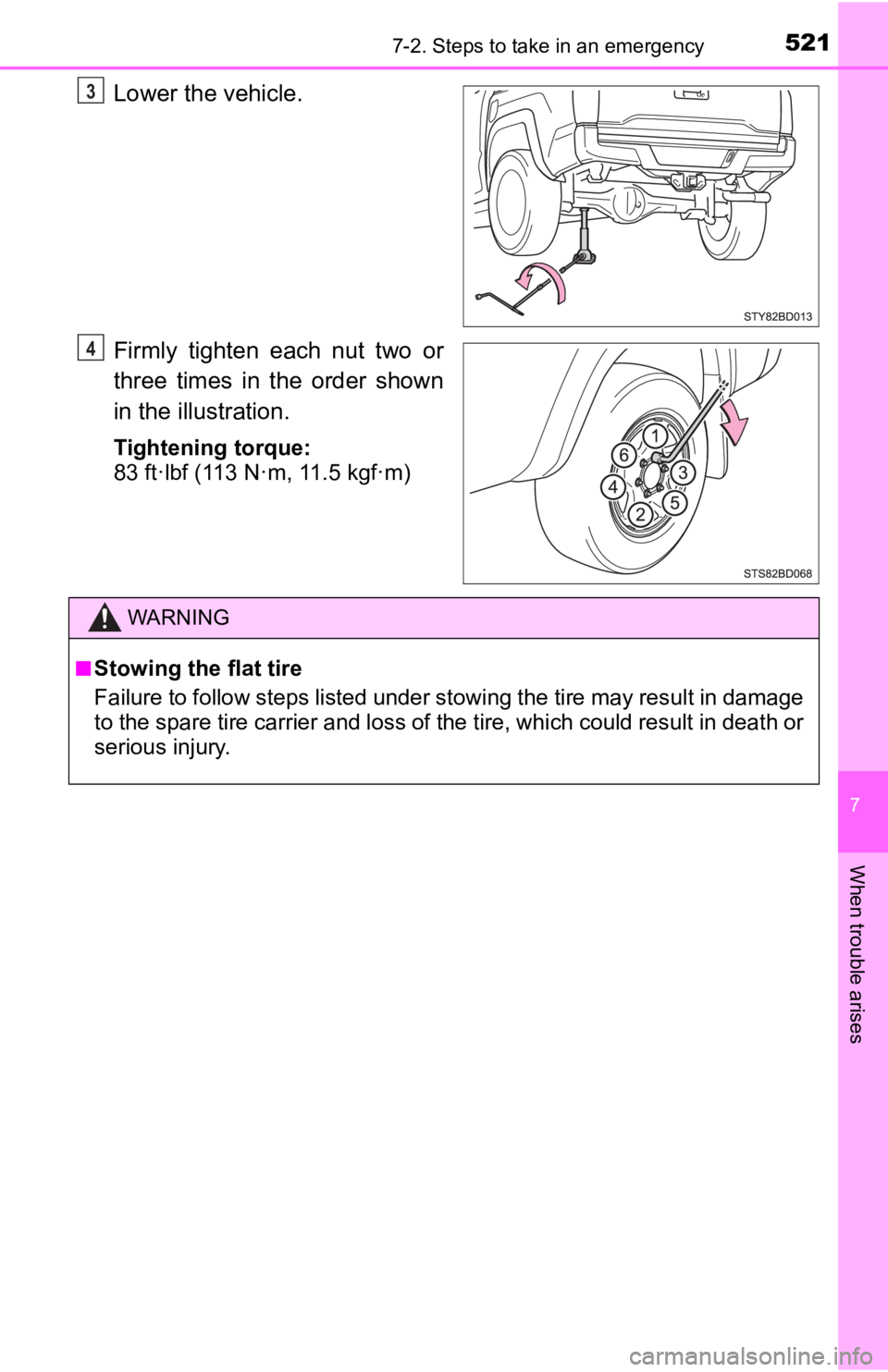
5217-2. Steps to take in an emergency
7
When trouble arises
Lower the vehicle.
Firmly tighten each nut two or
three times in the order shown
in the illustration.
Tightening torque:
83 ft·lbf (113 N·m, 11.5 kgf·m)
3
4
WARNING
■Stowing the flat tire
Failure to follow steps listed under stowing the tire may result in damage
to the spare tire carrier and loss of the tire, which could res ult in death or
serious injury.
Page 522 of 616
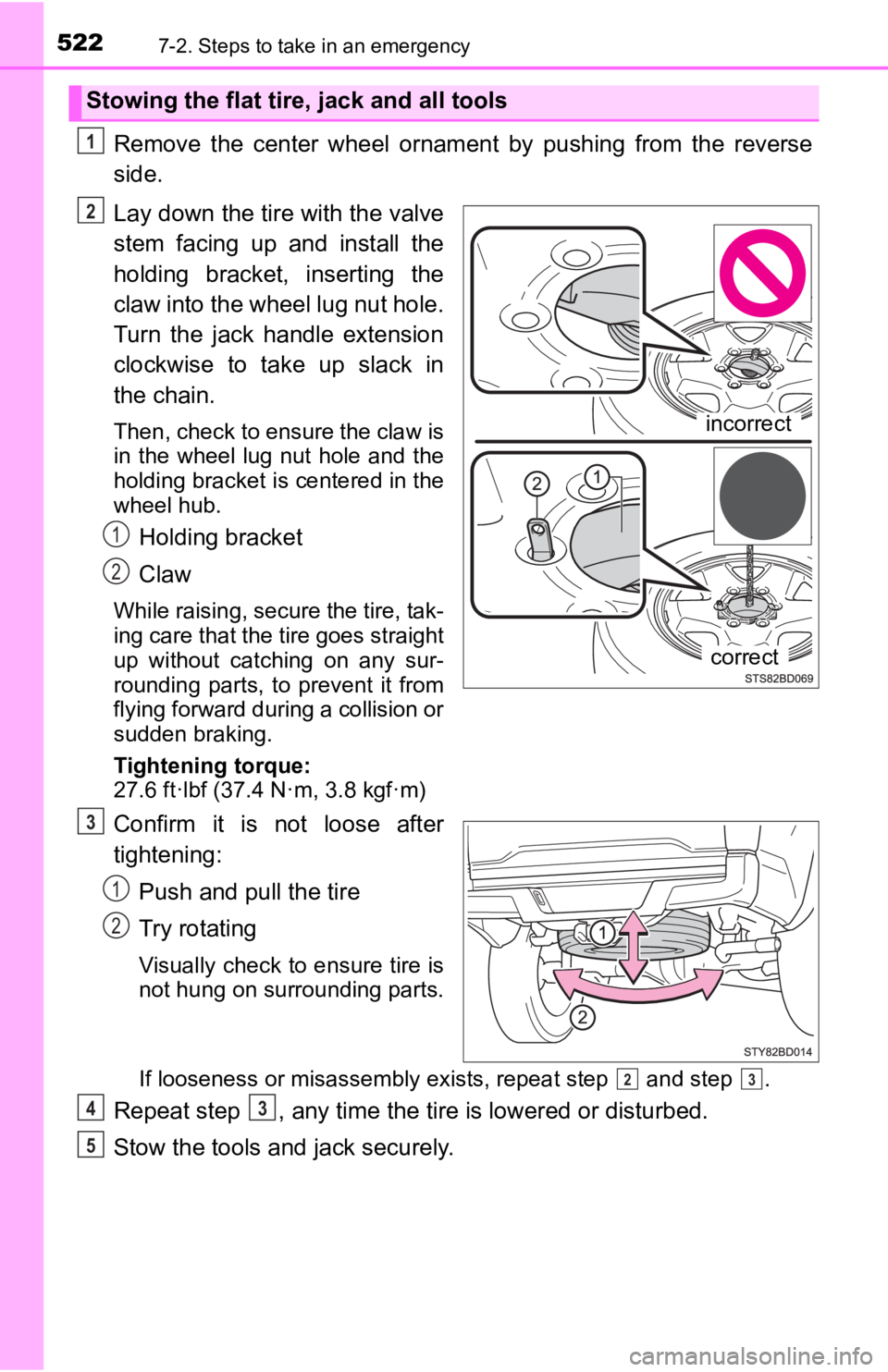
5227-2. Steps to take in an emergency
Remove the center wheel ornament by pushing from the reverse
side.
Lay down the tire with the valve
stem facing up and install the
holding bracket, inserting the
claw into the wheel lug nut hole.
Turn the jack handle extension
clockwise to take up slack in
the chain.
Then, check to ensure the claw is
in the wheel lug nut hole and the
holding bracket is centered in the
wheel hub.
Holding bracket
Claw
While raising, secure the tire, tak-
ing care that the tire goes straight
up without catching on any sur-
rounding parts, to prevent it from
flying forward during a collision or
sudden braking.
Tightening torque:
27.6 ft·lbf (37.4 N·m, 3.8 kgf·m)
Confirm it is not loose after
tightening:
Push and pull the tire
Try rotating
Visually check to ensure tire is
not hung on surrounding parts.
If looseness or misassembly ex ists, repeat step and step .
Repeat step , any time the tire is lowered or disturbed.
Stow the tools and jack securely.
Stowing the flat tire, jack and all tools
1
incorrect
correct
2
1
2
3
1
2
23
43
5
Page 523 of 616

5237-2. Steps to take in an emergency
7
When trouble arises
■The temporary spare tire
●Your vehicle is equipped with a temporary spare tire that may be a differ-
ent size, tread type, and/or manufacturer from the ground tires installed
on your vehicle.
●The temporary spare tire is iden tified by the “TEMPORARY USE ON LY ”
marking on the disc wheel and/or the tire sidewall.
Use the temporary spare tire temp orarily, and only in an emergency.
●Make sure to check the tire inflation pressure of the temporary spare
tire. ( P. 5 5 1 )
■After completing the tire change (vehicles with the tire pressu re
warning system)
The tire pressure warni ng system must be reset. ( P. 433)
■When using the temporary spare tire (vehicles with the tire pre ssure
warning system)
As the temporary spare tire is no t equipped with the tire pressure warning
valve and transmitter, low inflation pressure of the spare tire will not be
indicated by the tire pressure warning system. Also, if you rep lace the
temporary spare tire after the tire pressure warning light come s on, the
light remains on.
■If you have a flat rear tire on a road covered with snow or ice
Install the temporary spare tire on one of the front wheels of the vehicle.
Perform the following steps and f it tire chains to the rear tires:
Replace a front tire with the temporary spare tire.
Replace the flat rear tire with the tire removed from the front of the
vehicle.
Fit tire chains to the rear tires.
1
2
3
Page 524 of 616

5247-2. Steps to take in an emergency
WARNING
■When using the temporary spare tire
●Remember that the temporary spare tire provided is specifically
designed for use with your vehicle. Do not use your temporary spare
tire on another vehicle.
●Do not use more than one temporary spare tires simultaneously.
●Replace the temporary spare tire with a standard tire as soon a s possi-
ble.
●Avoid sudden acceleration, abrupt steering, sudden braking and shift-
ing operations that cause sudden engine braking.
■When the spare tire is attached
The vehicle speed may not be co rrectly detected, and the following sys-
tems may not operate correctly:
Also, not only can the following system not be utilized fully, but it may
even negatively affect the drive-train components:
• 4WD system
■Speed limit when using th e temporary spare tire
Do not drive at speeds in excess of 50 mph (80 km/h) when a temporary
spare tire is installed on the vehicle.
The temporary spare tire is not designed for driving at high sp eeds. Fail-
ure to observe this precaution may lead to an accident causing death or
serious injury.
• ABS & Brake assist
• VSC
• TRC
• AUTO LSD
• Dynamic radar cruise control
(if equipped)
• Pre-Collision System (if equipped)
• Automatic High Beam (if equipped)
• LDA (Lane Departure Alert) (if
equipped)
• Hill-start assist control
(if equipped)
• Cruise control (if equipped)
• Active traction control system (if equipped)
• Multi Terrain ABS (if equipped)
• Multi-terrain Select (if equipped)
• Crawl Control (if equipped)
• Navigation system (if equipped)
Page 525 of 616

5257-2. Steps to take in an emergency
7
When trouble arises
NOTICE
■Do not drive the vehicle with a flat tire
Do not continue driving with a flat tire.
Driving even a short distance with a flat tire can damage the tire and the
wheel beyond repair.
■Driving with tire chains a nd the temporary spare tire
Do not fit tire chains to t he temporary spare tire.
Tire chains may damage the vehicle body and adversely affect dr iving
performance.
■When replacing the tires (vehicles with the tire pressure warning
system)
When removing or fitting the wheels, tires or the tire pressure warning
valve and transmitter, contact your Toyota dealer as the tire p ressure
warning valve and transmitter may be damaged if not handled correctly.
■To avoid damage to the tire pressure warning valves and transmi t-
ters (if equipped)
When a tire is repaired with liquid sealants, the tire pressure warning valve and transmitter may not operate properly. If a liquid sea lant is
used, contact your Toyota dealer or other qualified service shop as soon
as possible. Make sure to replace the tire pressure warning valve and
transmitter when replacing the tire. ( P. 432)
Page 526 of 616
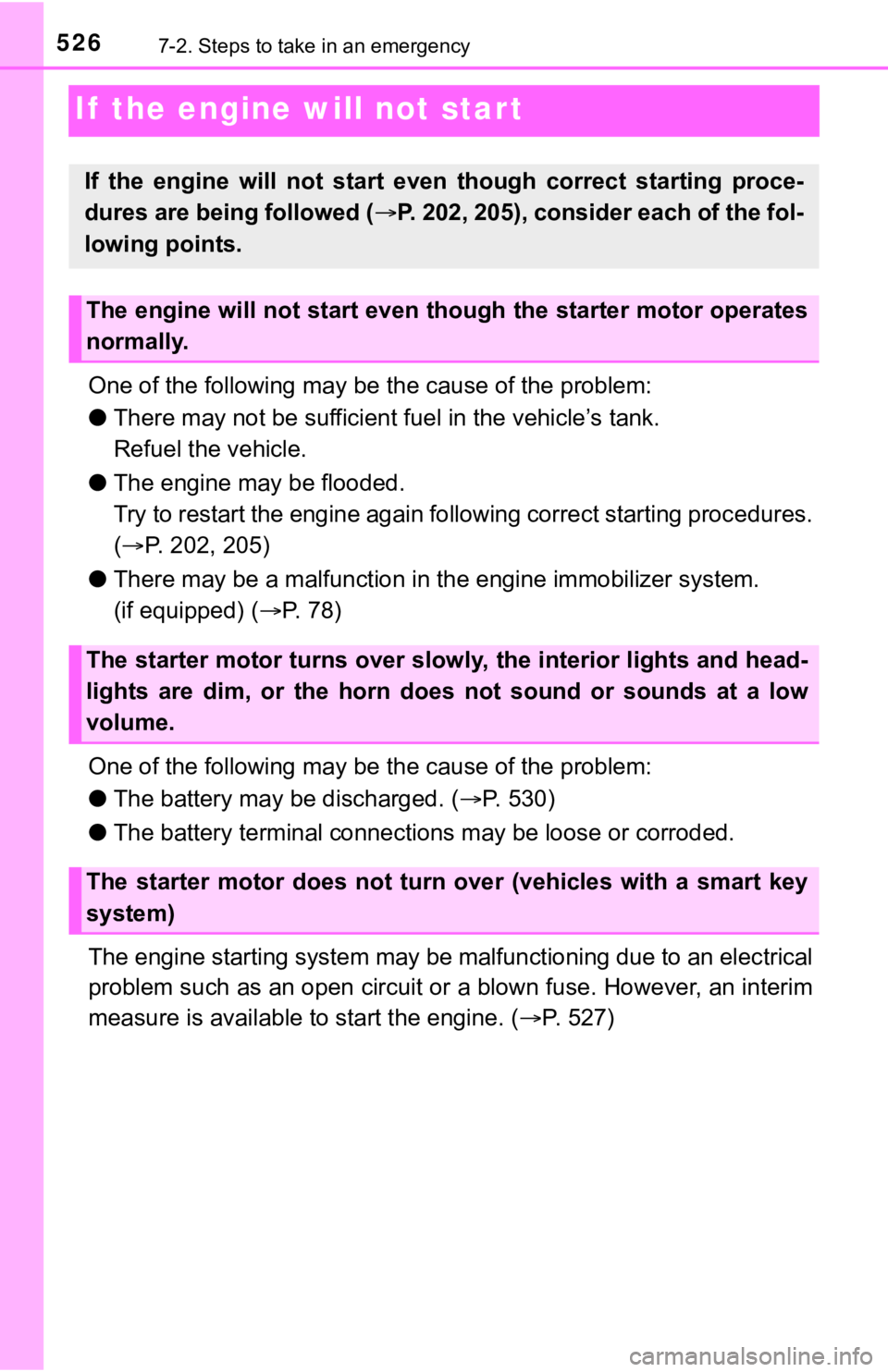
5267-2. Steps to take in an emergency
If the engine will not star t
One of the following may be the cause of the problem:
● There may not be sufficient f uel in the vehicle’s tank.
Refuel the vehicle.
● The engine may be flooded.
Try to restart the engine again following correct starting proc edures.
( P. 202, 205)
● There may be a malf unction in the engine immobilizer system.
(if equipped) ( P. 78)
One of the following may be the cause of the problem:
● The battery may be discharged. ( P. 530)
● The battery terminal connecti ons may be loose or corroded.
The engine starting system may be malfunctioning due to an elec trical
problem such as an open circuit or a blown fuse. However, an in terim
measure is available to start the engine. ( P. 527)
If the engine will not start eve n though correct starting proce -
dures are being followed ( P. 202, 205), consider each of the fol-
lowing points.
The engine will not start even t hough the starter motor operates
normally.
The starter motor turns over slowly, the interior lights and he ad-
lights are dim, or the horn does not sound or sounds at a low
volume.
The starter motor does not turn over (vehicles with a smart key
system)
Page 527 of 616

5277-2. Steps to take in an emergency
7
When trouble arises
One of the following may be the cause of the problem:
● One or both of the battery t erminals may be disconnected.
● The battery may be discharged. ( P. 530)
● There may be a malfunction in the steering lock system (vehicles
with a smart key system).
Contact your Toyota dealer if the problem cannot be repaired, o r if repair
procedures are unknown.
When the engine does not start, the following steps can be used as an
interim measure to start the engine if the engine switch is fun ctioning
normally:
Set the parking brake.
Shift the shift lever to P.
Turn the engine switch to ACCESSORY mode.
Press and hold the engine switch for about 15 seconds while
depressing the brake pedal firmly.
Even if the engine can be start ed using the above steps, the sy stem
may be malfunctioning. Have the vehicle inspected by your Toyot a
dealer.
The starter motor does not turn over, the interior lights and h ead-
lights do not turn on, o r the horn does not sound.
Emergency start function (vehicles with a smart key system)
1
2
3
4
Page 528 of 616
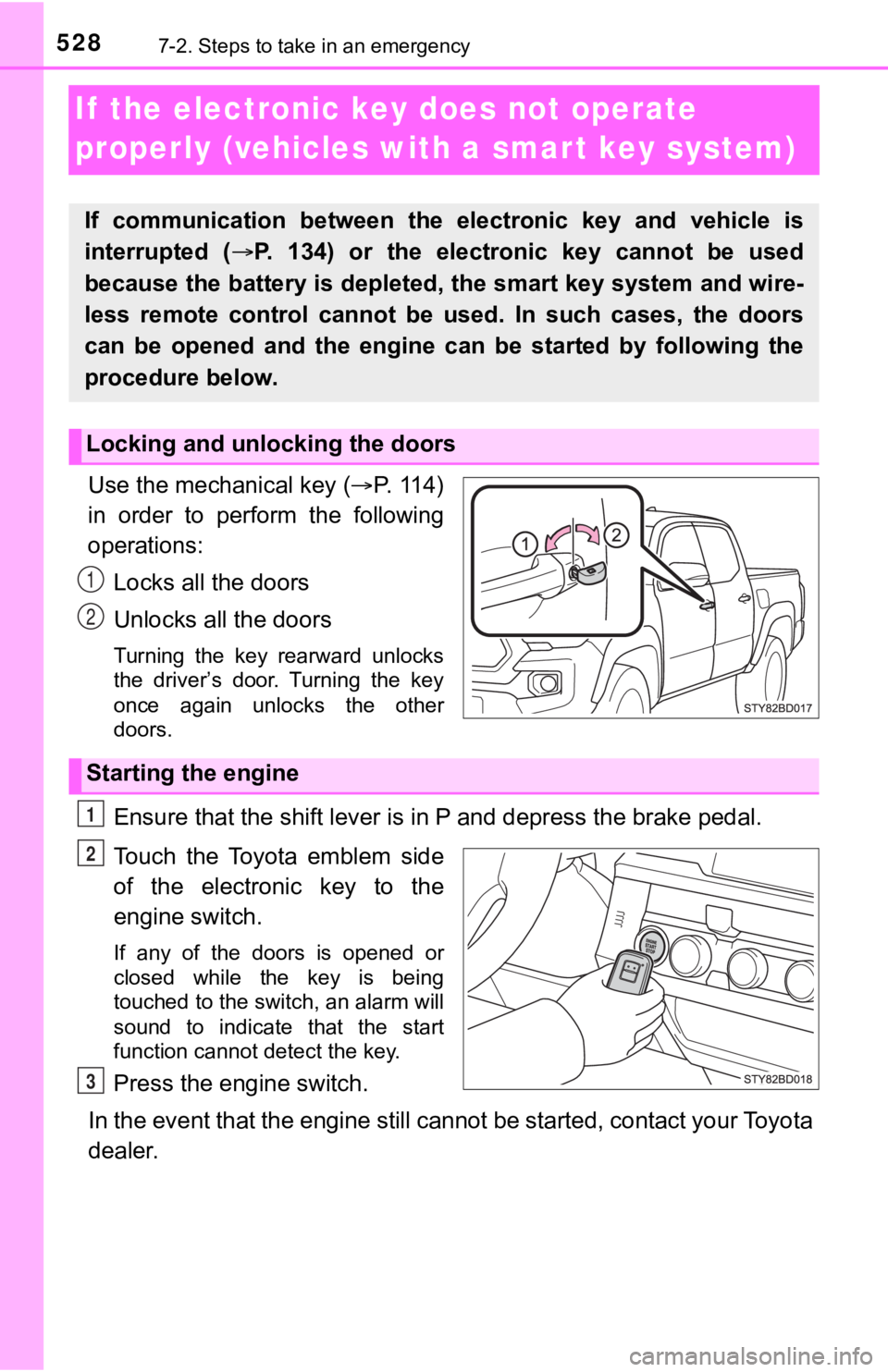
5287-2. Steps to take in an emergency
If the electronic key does not operate
properly (vehicles with a smar t key system)
Use the mechanical key (P. 114)
in order to perform the following
operations:
Locks all the doors
Unlocks all the doors
Turning the key rearward unlocks
the driver’s door. Turning the key
once again unlocks the other
doors.
Ensure that the shift lever is in P and depress the brake pedal.
Touch the Toyota emblem side
of the electronic key to the
engine switch.
If any of the doors is opened or
closed while the key is being
touched to the switch, an alarm will
sound to indicate that the start
function cannot detect the key.
Press the engine switch.
In the event that the engine still cannot be started, contact your Toyota
dealer.
If communication between the electronic key and vehicle is
interrupted ( P. 134) or the electronic key cannot be used
because the battery is depleted, the smart key system and wire-
less remote control cannot be used. In such cases, the doors
can be opened and the engine c an be started by following the
procedure below.
Locking and unlocking the doors
1
2
Starting the engine
1
2
3
Page 529 of 616

5297-2. Steps to take in an emergency
7
When trouble arises
■Stopping the engine
Shift the shift lever to P and press the engine switch as you normally do when
stopping the engine.
■ Replacing the key battery
As the above procedure is a temporary measure, it is recommende d that the
electronic key battery be replaced immediately when the battery is depleted.
( P. 451)
■ Changing engine switch modes
Within 10 seconds of the buzzer sounding, release the brake ped al and press
the engine switch.
The engine does not start and modes will be changed each time t he switch is
pressed. ( P. 206)
Page 530 of 616
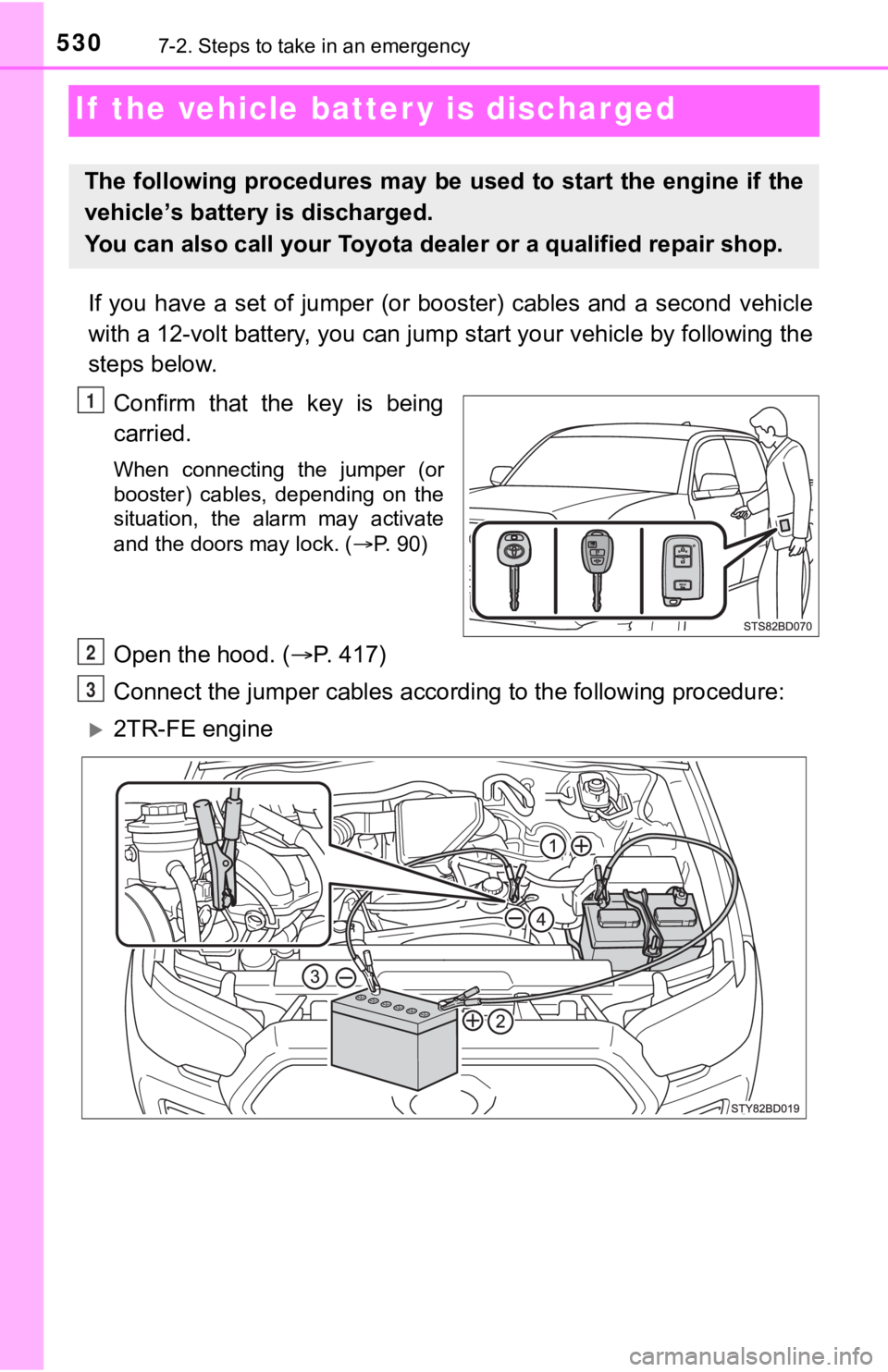
5307-2. Steps to take in an emergency
If the vehicle batter y is discharged
If you have a set of jumper (or booster) cables and a second ve hicle
with a 12-volt battery, you can jump start your vehicle by foll owing the
steps below.
Confirm that the key is being
carried.
When connecting the jumper (or
booster) cables, depending on the
situation, the alarm may activate
and the doors may lock. ( P. 90)
Open the hood. (P. 417)
Connect the jumper cables according to the following procedure:
2TR-FE engine
The following procedures may be used to start the engine if the
vehicle’s battery is discharged.
You can also call your Toyota de aler or a qualified repair shop.
1
2
3